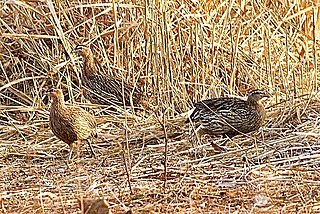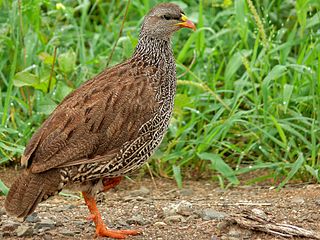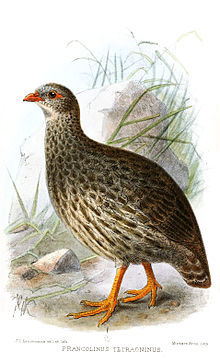
The Phasianidae are a family of heavy, ground-living birds, which includes pheasants, partridges, junglefowl, chickens, turkeys, Old World quail, and peafowl. The family includes many of the most popular gamebirds. The family is a large one and includes 185 species divided into 54 genera. It was formerly broken up into two subfamilies, the Phasianinae and the Perdicinae. However, this treatment is now known to be paraphyletic and polyphyletic, respectively, and more recent evidence supports breaking it up into two subfamilies: Rollulinae and Phasianinae, with the latter containing multiple tribes within two clades. The New World quail (Odontophoridae) and guineafowl (Numididae) were formerly sometimes included in this family, but are now typically placed in families of their own; conversely, grouse and turkeys, formerly often treated as distinct families, are now known to be deeply nested within Phasianidae, so they are now included in the present family.

Francolins are birds in the tribe Gallini that traditionally have been placed in the genus Francolinus, but now commonly are divided into multiple genera.

The double-spurred spurfowl is a gamebird in the pheasant family Phasianidae of the order Galliformes, gallinaceous birds. Like most spurfowls, it is restricted to Africa. It is a resident breeder in tropical west Africa, but there is a small and declining isolated population in Morocco.

The red-necked spurfowl or red-necked francolin, is a gamebird in the pheasant family Phasianidae that is a resident species in southern Africa.

Hartlaub's spurfowl or Hartlaub's francolin is a species of bird in the pheasant family Phasianidae. It is endemic to the escarpment zone of Namibia and Angola. The common name and Latin binomial commemorate the German physician and ornithologist Gustav Hartlaub.

The Cape spurfowl or Cape francolin is a gamebird in the pheasant family Phasianidae. It is endemic to southern Africa, where it is the largest francolin. It occurs in the Western Cape province of South Africa, and locally northwards to southern Namibia. It has adapted to alien vegetation and a variety of human-altered habitats, but scrubby roosting and nesting space is a prerequisite. The species is not threatened.

The Ahanta francolin or Ahanta spurfowl is a species of bird in the pheasant family, Phasianidae. It is native to western Africa, where it occurs in Benin, Ivory Coast, Gambia, Ghana, Guinea, Guinea-Bissau, Liberia, Mali, Nigeria, Senegal, Sierra Leone, and Togo.

Clapperton's spurfowl is a species of bird in the family Phasianidae. It is found in Cameroon, Central African Republic, Chad, Eritrea, Ethiopia, Mali, Mauritania, Niger, Nigeria, Sudan, and Uganda.

Erckel's spurfowl, also known as Erckel's francolin, is a species of game bird in the family Phasianidae.

Harwood's spurfowl, also known as Harwood's Francolin, is a species of bird in the family Phasianidae. It is a grey-brown bird with red bill and tail, and red bare skin around the eyes. Both sexes have similar coloring, although the female is paler in color with a more extensive buff belly.

Hildebrandt's spurfowl is a species of bird in the family Phasianidae. It is found in Burundi, Democratic Republic of the Congo, Kenya, Malawi, Mozambique, Rwanda, Tanzania, and Zambia. The species is named for Johann Maria Hildebrandt, who collected the first specimens in Kenya. The sexes differ markedly in their plumage and females are smaller than males.

Heuglin's spurfowl is a species of bird in the family Phasianidae. It is found in Central African Republic, Democratic Republic of the Congo, South Sudan, and Uganda. The German explorer Theodor von Heuglin first described the species.

The Natal spurfowl or Natal francolin is a species of bird in the family Phasianidae. It is found in Botswana, Eswatini, Mozambique, South Africa, Zambia, and Zimbabwe.

The Djibouti spurfowl or Djibouti francolin is a bird species in the pheasant family, Phasianidae. It is critically endangered and found only in Djibouti, a nation in the Horn of Africa. This species is grayish-brown overall with white stripes and streaks on its underparts which become finer towards the upperparts. It has black markings on the head and a gray crown and has a short tail. It is 35 cm (1.15 ft) in length, and weighs 940 g (33 oz).

The grey-breasted spurfowl or grey-breasted francolin is a species of bird in the family Phasianidae. It is found only in Tanzania.

The crested francolin is a species of bird in the family Phasianidae. It is found in southern Africa. One of its subspecies, Ortygornis sephaena rovuma, is sometimes considered a separate species, Kirk's francolin.

The scaly spurfowl is a species of bird in the family Phasianidae. It is found in Angola, Burundi, Cameroon, Central African Republic, Republic of the Congo, Democratic Republic of the Congo, Equatorial Guinea, Ethiopia, Gabon, Kenya, Malawi, Nigeria, Rwanda, São Tomé and Príncipe, Sudan, Tanzania, and Uganda.

Perdicinae is a polyphyletic former subfamily of birds in the pheasant family, Phasianidae, regrouping the partridges, Old World quails, and francolins. Although this subfamily was considered monophyletic and separated from the pheasants, tragopans, junglefowls, and peafowls (Phasianinae) till the early 1990s, molecular phylogenies have shown that these two subfamilies actually constitute only one lineage. For example, some partridges are more closely affiliated to pheasants, whereas Old World quails and partridges from the Alectoris genus are closer to junglefowls. Due to this, the subfamily Perdicinae is no longer recognized by the International Ornithological Congress, with the species being split among 3 subfamilies.

Ortygornis is a genus of birds in the francolin group of the family Phasianidae.























